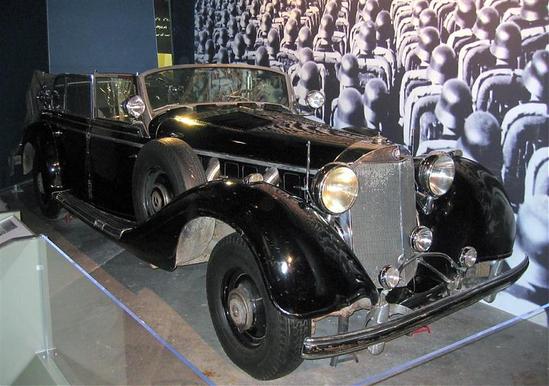Hitler's Limousine
Grosser Mercedes, Model 770 w 150 Type II convertible limousine
Canadian War Museum

Hitler's limousine, image courtesy BenzWorld.org
It's a Lada-style presentation for perhaps the most notorious Daimler-Benz limousine in the world. Phony geraniums in window boxes sprouting from white walls, heart-shaped cutouts in woodwork, and a loud, glaringly bad recording of Nazis singing or marching, create quite the counterpoint to the massive black limousine squeezed into the corner. Waving aside any issues around political correctness, this cottage-like setting for what is described as "Hitler's Limousine," is downright tacky and in irredeemably bad taste.
Late last week, over 200 voice- and e-mails from Canadians against a sale, moved Dr. Jack Granatstein, the Canadian War Museum's (CWM) director and CEO, to mothball his plan to put this car on the auction block.
In doing so, he's saved us all from living with the terrible irony of using money from the sale of Hitler's luxury convertible for the upkeep of our national war museum.
Donated to the CWM over thirty years ago by a wealthy Quebec businessman, Granatstein claims its worth could be $20 million Canadian today. At that value and noting that it falls outside CWM's mandate and has no direct connection to Canada, the "For Sale" sign beckoned to Granatstein. Twenty million dollars would be the magic wand in the CWM's long-standing struggle to leave its cramped and inadequate quarters and move to a new and bigger home.
"'This is political correctness. You are trying to bury part of our history. We object.' About half of the messages I had took that line." Granatstein was partially heartened by this response. "I've spent a lot of time fighting against political correctness and [championing] the need to present history as it happened," he says.
But the public response and Granatstein's fears about the car becoming an icon for a right-wing group have had an impact. The car stays.
"In its current state, it says 'glamour' and 'power'," says Granatstein. "That is a perfect example of how you can't let the artifact drive the story." Of the setting, he adds, "As long as we're in this building, it's gonna stay where it is. We'd have to knock down walls to move it."
But its fate in a new CWM is an open question. "If you were going to continue to show the car," says Granatstein, "You would have to find a way to let visitors and particularly kids know ... where Nazism got its appeal, why it had the impact it did in Germany, where and how it went in a dangerous direction."
It appears inevitable that in any epic atrocity like war, genocide as in slavery or the Holocaust for instance, there will be associated beautiful or glamourous objects. The dilemma in museums is how to display them and why. How can this car tell us something about Hitler and his time and why?
Wouldn't it be ethically convenient for us if everything in the world appropriately fell into two categories, with all ugliness rotting away in the "evil" camp and all beauty glowing in the "good" one? Perhaps this is about laziness and lack of time to see and not just look.
"The CWM now, in my view, is an artifact oriented museum and I very much want to change it to being a history-oriented museum," says Granatstein. "In a sense that's what's happening in this dispute - my orientation is running head on into a public orientation that is artifact oriented. This concerns me."
If "Hitler's limousine" was a beaten up old Lada or jeep, it's difficult to believe that this controversy would've arisen at all. The vehicle wouldn't be worth as much. Secondly, some of us wouldn't be feeling quite so uneasy about its power. The black Merc is daunting and threatening - not just because Hitler owned it.
At almost 20-feet long the shiny armoured limo boasts bulbous tire guards, massive headlights, and luxurious interiors. The bullet-holes in the glass windows further mythologize it in part since no one knows exactly how they got there.
The CWM needs to raise $15 million. Five million has been raised so far. In the meantime, let's hope the management gets rid of the music, the hearts and the dusty geraniums. That shouldn't cost too much.
Published in The Ottawa Xpress
Late last week, over 200 voice- and e-mails from Canadians against a sale, moved Dr. Jack Granatstein, the Canadian War Museum's (CWM) director and CEO, to mothball his plan to put this car on the auction block.
In doing so, he's saved us all from living with the terrible irony of using money from the sale of Hitler's luxury convertible for the upkeep of our national war museum.
Donated to the CWM over thirty years ago by a wealthy Quebec businessman, Granatstein claims its worth could be $20 million Canadian today. At that value and noting that it falls outside CWM's mandate and has no direct connection to Canada, the "For Sale" sign beckoned to Granatstein. Twenty million dollars would be the magic wand in the CWM's long-standing struggle to leave its cramped and inadequate quarters and move to a new and bigger home.
"'This is political correctness. You are trying to bury part of our history. We object.' About half of the messages I had took that line." Granatstein was partially heartened by this response. "I've spent a lot of time fighting against political correctness and [championing] the need to present history as it happened," he says.
But the public response and Granatstein's fears about the car becoming an icon for a right-wing group have had an impact. The car stays.
"In its current state, it says 'glamour' and 'power'," says Granatstein. "That is a perfect example of how you can't let the artifact drive the story." Of the setting, he adds, "As long as we're in this building, it's gonna stay where it is. We'd have to knock down walls to move it."
But its fate in a new CWM is an open question. "If you were going to continue to show the car," says Granatstein, "You would have to find a way to let visitors and particularly kids know ... where Nazism got its appeal, why it had the impact it did in Germany, where and how it went in a dangerous direction."
It appears inevitable that in any epic atrocity like war, genocide as in slavery or the Holocaust for instance, there will be associated beautiful or glamourous objects. The dilemma in museums is how to display them and why. How can this car tell us something about Hitler and his time and why?
Wouldn't it be ethically convenient for us if everything in the world appropriately fell into two categories, with all ugliness rotting away in the "evil" camp and all beauty glowing in the "good" one? Perhaps this is about laziness and lack of time to see and not just look.
"The CWM now, in my view, is an artifact oriented museum and I very much want to change it to being a history-oriented museum," says Granatstein. "In a sense that's what's happening in this dispute - my orientation is running head on into a public orientation that is artifact oriented. This concerns me."
If "Hitler's limousine" was a beaten up old Lada or jeep, it's difficult to believe that this controversy would've arisen at all. The vehicle wouldn't be worth as much. Secondly, some of us wouldn't be feeling quite so uneasy about its power. The black Merc is daunting and threatening - not just because Hitler owned it.
At almost 20-feet long the shiny armoured limo boasts bulbous tire guards, massive headlights, and luxurious interiors. The bullet-holes in the glass windows further mythologize it in part since no one knows exactly how they got there.
The CWM needs to raise $15 million. Five million has been raised so far. In the meantime, let's hope the management gets rid of the music, the hearts and the dusty geraniums. That shouldn't cost too much.
Published in The Ottawa Xpress

